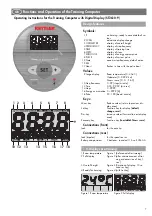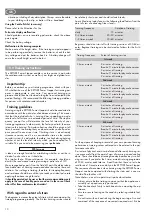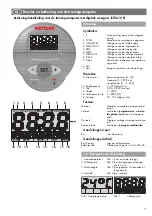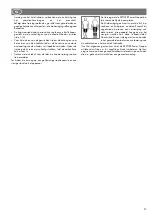
9
GB
ning, and you will hear a
bleep
.
When you have commenced training, automatic display-change
SCAN
(symbol 2 in the display) will take place at intervals of 5 se-
conds. You can de-activate it by pressing the
Set
-key. Using the
+/–
key, you can transfer forward or back to the next or previous dis-
play area. If you have activated the step-frequency default-setting
note (12) in the display, a bleep will sound which will coincide with
the step-frequency per default-setting. This is intended to help you
keep time.
By pressing the
+/–
keys
together
, you will de-activate the acoustic
step-frequency, and the note (12) is no longer displayed. This is
also possible when training is interrupted.
Additional remark
When a default-setting is reached (excluding pulse-rate limit and
step-frequency), it will appear at once in the large display (9).
If you discontinue the stepping action, the system’s electronics iden-
tify an interruption of training. Automatic display-change is de-ac-
tivated. The symbol
SCAN
disappears,
P
is displayed, and the pulse
rate is shown in the large display, where it remains. If you do not
resume training within 4 minutes, the display switches to
Room tem-
perature
(Figure 1). The
distance
covered is then added up to pro-
duce the overall height. All
other
values
are not saved
.
Additional remark
Using the
+/–
key, you can transfer forward or back to the next or
previous display area.
The
Set
-key returns you to input mode, in the process of which all
previous training data and default-settings are deleted.
Proceed with training. The
values resume counting
.
The training computer is equipped with a recovery pulse rate
function. This enables you to measure your recovery pulse rate once
you have completed training. Press the recovery pulse rate key once
you have completed training. The computer will measure your pulse
rate over a period of 60 seconds, counting in reverse order (Figure
12). After that, a fitness score is displayed accompanied by an (
F
)
(Figure 13). The calculation procedure is explained under 9.0 Ge-
neral information. If the pulse-rate measurement procedure is in-
terrupted, (
P
) together with (
E
) for Error message are displayed
instead of a value (Figure 14). If you press the Recovery-key, the dis-
play of current training data reappears.
Figure 12
Figure 13
8.0 Recovery pulse rate measurement
7.0 Display upon resuming training
6.0 Display before training, upon interrup-
tion/completion of training
5.0 Display in training
Figure 14
Figure 12: Recovery pulse rate measurement with reverse-motion
timing ((0:60 - 0:00)
Figure 13: Display of fitness score
Figure 14: No pulse rate identified for recovery pulse rate mea-
surement procedure
Additional remark
If no pulse value is displayed, the recovery-pulse function is not car-
ried out.
Calculation of overall height
1 step action equates to a height of 0.19 metres.
Calculation of kilojoules
According to information available to us from the field of Sports
Medicine, energy is consumed as follows during step-action trai-
ning: 1 hour of step-action training uses up 2,500 kj based on a
step-frequency of 90 steps per minute. 1,000 steps equate to 465
kilojoule.
This calculation is based on medium load and changes only where
the step-frequency is varied.
Calculation of fitness score
The computer calculates and evaluates the difference between the
load pulse and the recovery pulse and arrives at its “fitness score”
by applying the following formula:
Note ( F ) = 6 –
(
10 x ( P1 – P2 )
)
2
P1
P1 = Load pulse
P2 = Recovery pulse
Score of 1 = very good
Score of 6 = poor
Physical fitness can be monitored easily and quickly by comparing
the load pulse with the recovery pulse. The fitness score is an ori-
entation value, which reflects your ability to recover following phy-
sical strain. Before pressing the recovery pulse rate key to work out
your fitness score, you should continue exercising within your exer-
tion range over an extended period, i.e. at least 10 minutes. If you
engage in regular exercise of the cardiovascular system, you will
discover that your “fitness score” will improve with time.
Information on measuring pulse rate
Calculation of the pulse rate commences when the heart in the dis-
play flashes in time with your pulse beat.
With ear clip
The pulse sensor operates with infrared light and measures the
changes in the light transmission ratio of your skin, which are trig-
gered by your pulse beat. Before you attach the pulse sensor to
your ear lobe, rub it vigorously 10 times to stimulate the blood cir-
culation.
Avoid disruptive factors
• Attach the ear clip securely to your ear lobe and look for the
best spot at which to take the reading (heart symbol flashes un-
interruptedly).
• Do not exercise where you are directly exposed to strong light,
e.g. neon light, halogen lighting, spotlights, sunlight.
• Ensure that neither the ear clip nor its cable can be subjected to
9.0 General information










































